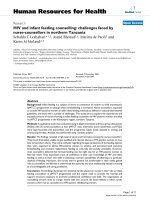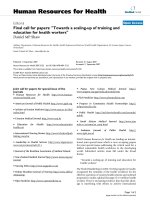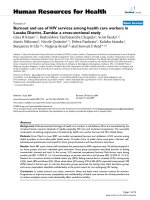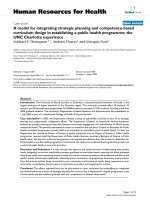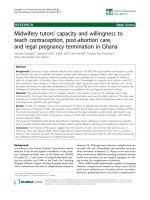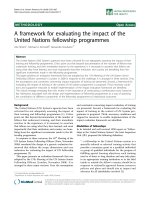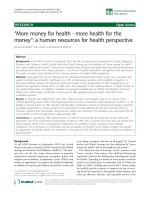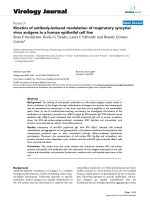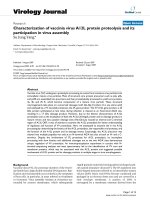báo cáo sinh học:" Public-private options for expanding access to human resources for HIV/AIDS in Botswana" pptx
Bạn đang xem bản rút gọn của tài liệu. Xem và tải ngay bản đầy đủ của tài liệu tại đây (246.08 KB, 7 trang )
BioMed Central
Page 1 of 7
(page number not for citation purposes)
Human Resources for Health
Open Access
Review
Public-private options for expanding access to human resources for
HIV/AIDS in Botswana
Norbert Dreesch*
1
, Jennifer Nyoni
2
, Ontlametse Mokopakgosi
3
,
Khumo Seipone
4
, Jean Alfazema Kalilani
5
, Owen Kaluwa
6
and
Vincent Musowe
5,7
Address:
1
Human Resources for Health, World Health Organization, Geneva, Switzerland,
2
Human Resources for Health Management, World
Health Organization, Regional Office for Africa, Brazzaville, Congo,
3
Policy, Planning, Monitoring and Evaluation, Ministry of Health, Gaborone,
Botswana,
4
Department of HIV/AIDS Prevention and Care, Ministry of Health, Gaborone, Botswana,
5
World Health Organization, Botswana,
6
HIV, World Health Organization, Botswana and
7
Ministry of Health, Zambia
Email: Norbert Dreesch* - ; Jennifer Nyoni - ; Ontlametse Mokopakgosi - ;
Khumo Seipone - ; Jean Alfazema Kalilani - ; Owen Kaluwa - ;
Vincent Musowe -
* Corresponding author
Abstract
In responding to the goal of rapidly increasing access to antiretroviral treatment (ART), the
government of Botswana undertook a major review of its health systems options to increase access
to human resources, one of the major bottlenecks preventing people from receiving treatment. In
mid-2004, a team of government and World Health Organization (WHO) staff reviewed the
situation and identified a number of public sector scale up options. The team also reviewed the
capacity of private practitioners to participate in the provision of ART. Subsequently, the
government created a mechanism to include private practitioners in rolling out ART. At the end of
2006, more than 4500 patients had been transferred to the private sector for routine follow up. It
is estimated that the cooperation reduced the immediate need for recruiting up to 40 medically
qualified staff into the public sector over the coming years, depending on the development of the
national standard for the number and duration of patient visits to a doctor per year. Thus welcome
relief was brought, while at the same time not exercising a pull factor on human resources for
health in the sub-Saharan region.
Review
Botswana is a sub-Saharan African country in which the
HIV prevalence is among the highest in the world (see
Table 1). The epidemic reached mature proportions over
the past decade, with deaths from the disease affecting all
strata of society. Given the alarming prevalence figures
reported during the 1990s, presidential level commitment
assured a strong response to the expanding epidemic
throughout Botswana society by creating the National
AIDS Coordinating Agency in 2002.
As of the mid-1990s, ART became increasingly affordable
globally. As a middle-income country, Botswana decided
with the highest political commitment to invest heavily
through creating the ART Programme to address the need
to provide access to antiretroviral therapy. In 2000 the
Published: 19 October 2007
Human Resources for Health 2007, 5:25 doi:10.1186/1478-4491-5-25
Received: 13 February 2007
Accepted: 19 October 2007
This article is available from: />© 2007 Dreesch et al; licensee BioMed Central Ltd.
This is an Open Access article distributed under the terms of the Creative Commons Attribution License ( />),
which permits unrestricted use, distribution, and reproduction in any medium, provided the original work is properly cited.
Human Resources for Health 2007, 5:25 />Page 2 of 7
(page number not for citation purposes)
government contracted the McKinsey consulting com-
pany who conducted a situation assessment for the estab-
lishment of the ART Program. In addition, they provided
an analysis of treatment needs and a way to organize the
ART programme. The target coverage of need for ART and
care was established at 110 000 patients as a result of this
consultancy [1].
As an initial emergency response, a public-sector antiret-
roviral programme was created to focus support on deliv-
ery of this specific component of HIV/AIDS prevention,
care and treatment services.
In mid-2004, this programme had evolved to consist of
specialized antiretroviral therapy public clinics estab-
lished in existing health care facilities and operating in
four sites across the country. A site consists of one hospital
with up to four satellite clinics. At that time, the popula-
tion response to the need for testing for HIV was such that
10 000 patients who had tested positive and were found
to be in need of ART could not start therapy due to insuf-
ficient access to the health workforce. Thus, there was a
need to identify other health system resources to provide
access to human resources for ART.
In the meantime, many other donors and bilateral aid
agencies, including the Bill & Melinda Gates Foundation,
Baylor College of Medicine and Harvard University, CDC-
Botswana, Bristol-Myers Squibb, the African Comprehen-
sive HIV/AIDS Partnerships (ACHAP) had all become
active collaborators in teaching, training, setting up labo-
ratory facilities or designing a roll-out programme for
antiretroviral care. Likewise, the World Health Organiza-
tion (WHO) provided technical assistance to set up the
programme by fielding an officer to support the creation
and roll-out of a training programme called KITSO
('Knowledge, Innovation, and Training Shall Overcome
AIDS', KITSO is the Setswana word for 'knowledge').
Increasing international support and national response
One of the priorities of the WHO Director-General, the
late Dr LEE Jong-wook, who took office in July 2003, was
increasing access to anti-retroviral care. This led to the
announcement of the goal of reaching half of the 6 mil-
lion in need globally with access to treatment at the end
of 2005. This was announced on World AIDS Day in
December 2003 [2].
Given the impetus of the '3 by 5' initiative starting in
2004, serving those waiting for access to care was critical
in a number of ways in Botswana:
• avoiding unnecessary suffering and premature deaths;
• maintaining the momentum of population response to
come forward for testing by offering rapid access to treat-
ment in case of need;
• avoiding public discontent with service provision and
possible negative consequences for the uptake of HIV test-
ing;
• increasing morale levels among staff, who could now see
that treatment was possible but should not be allowed to
become frustrated by the continuing lack of access.
The ensuing WHO technical support in mid-2004
brought together a multidisciplinary team from the Min-
istry of Health and WHO to address the issues of increas-
ing access to human resources within the current health
system, with a particular focus on HIV/AIDS care services.
The health workforce situation in Botswana in 2004
With the exception of nursing and some other non-medi-
cal staff, Botswana relies heavily on importing human
resources, particularly doctors, both generalists and spe-
cialists. The country does not as yet have its own medical
school to respond to its medical workforce needs,
although plans are under way to add a medical school to
the existing university departments. Table 2 provides an
overview of the human resources situation in the country
in 2004.
To roll out the antiretroviral therapy strategy throughout
the country, a number of additional positions were
authorized in the public sector to allow for phased imple-
Table 1: Country background data [10,11,12]
Total population 1 765 000 (2004)
GNI per capita (International $) 8 920 (2004)
Under- five mortality m/f (per 1000) 116 (2004)
Adult mortality m/f (per 1000) 786/710 (2004)
Total health expenditure per capita (International $) 375 (2004)
Total health expenditure as % of GDP 5.6 (2004)
National HIV prevalence 17.10% (2004)
Number HIV positive women (15–49) 157 783 (2005) (Sentinel survey data)
Number HIV positive men (15–49) 98 423 (2005) (Sentinel survey data)
Human Resources for Health 2007, 5:25 />Page 3 of 7
(page number not for citation purposes)
mentation. Table 3 presents the positions approved to
start scale-up in 2004. These contract positions attracted
personnel from the Southern African Development Com-
munity (SADC) region.
The core team needed to start providing ART services was
identified as presented in Table 4. The core support team
at satellite clinics and its composition to start treatment is
depicted in Table 5 and patient enrolment targets had
been set as indicated in Table 6.
Challenges and opportunities for scaling up access to
human resources
In 2004, approximately 21 000 persons were on treatment
and 10 000 whose CD4 cell count had been established
were awaiting access to treatment [3]. The treatment goal
of the 3 by 5 initiative was to reach half of the target of 110
000 people in need of ART by December 2005. Thus, by
mid-2004 another 34 000 more persons needed to be pro-
vided with access to treatment during the course of the
next 1.5 years.
Given that the available health workforce was providing
ART to 21 000 persons (approximately 1/3 private, 2/3
public sector human resources/ART and facility/equip-
ment access), the challenge of meeting the needs of an
additional 34 000 patients would correlate to additional
workforce needs.
Given the model of care at the time, the ART programme
had estimated the need for another 40 doctors for the 3 by
5 goal to be met, which would roughly translate into a
patient load of 850 patients per doctor per year. This fig-
ure seemed to be in line with findings from other recent
studies of ART treatment sites and workforce tasks and
skills use [4,5]. It should be noted, however, that great var-
iability in the need for coverage and physician skills was
also reported in these studies, depending on the distribu-
tion of tasks between the various categories in the care
team [4,5]. Given the difficulties likely to be encountered
in recruitment drives that would need to yield almost
immediate results, further local analyses were needed to
identify ways to provide care to more patients more effi-
Table 4: Core treatment team composition in the hospital,
minimum numbers to be placed to start treatment [14]
Secondment doctor 1
Physician/Medical officer 2
Paediatrician 1
Nurse 3
Phlebotomist (lab tech or retrained nurse) 2
Counsellors 3
Dietician/nutritionist 1
Administrative/data entry clerk 1
Pharmacist 2
Pharmacy technician 2
Total 18
Table 2: National human resources in Botswana, 2004 [13]
Type/category Established posts Filled posts Vacant posts
Medical specialists 182 165 17
Medical officers 407 370 37
Nurses 4753 4583 170
Pharmacists 145 140 5
Pharmacy technicians 211 193 18
Lab scientists 38 35 3
Lab technicians 167 160 7
Lab Assistants 23 21 2
Dieticians/nutritionists 24 19 5
Radiographers/radiology officers 64 61 3
Family Welfare Educators (FWEs) 981 829 152
Health education officers 50 48 2
Lay counsellors 302 300 2
Social workers 96 96 0
Table 3: Positions approved to start the PMTCT and ART
programme [14]
Category Established Filled Vacant
Medical specialists* 2 2 0
Medical officers 38 38 0
Nurses 129 127 2
Pharmacists 10 10 0
Pharmacy technicians 37 37 0
Lab technicians 17 16 1
Dieticians/nutritionists 2 2 0
Social workers 28 28 0
Lay counsellors 302 300 2
Human Resources for Health 2007, 5:25 />Page 4 of 7
(page number not for citation purposes)
ciently. This could include simplification of current ART
modalities, updating and transfer of skills, integration of
an ART package into in- and pre-service training modules,
diversification of training programmes to achieve a 3 by 5
responsive skill mix and the possible redistribution of
tasks within the treatment team.
The challenge of ART providers and their potential
Many institutions from the public and private sector, civil
society, community-based organizations and organiza-
tions of persons living with HIV/AIDS (PLWA) contribute
to the fight against HIV/AIDS in Botswana. In addition to
government public health services, the key institutions
involved in the delivery of ART services include mission
hospitals, the Botswana Defence Force (BDF), the Bot-
swana Meat Commission (BMC), the Debswana treat-
ment initiatives operating at Orapa and Jwaneng and the
Bamangwato Concessions Limited (BCL). Development
partners and NGO initiatives, including networks of
PLWA all support the ART program in one way or another.
The ART program has linkages with other programmes
such tuberculosis (TB), preventing mother-to-child trans-
mission (PMTCT), testing and counselling, and commu-
nity home-based care and all these interact to increase
access of the population to essential elements of a contin-
uum of care in HIV/AIDS.
As health programmes with specific goals and targets
mature, more experience is gained on ways to further
strengthen programme effectiveness and efficiency. In
terms of health workforce use and deployment, skills
development and skills distribution among staff, mature
programmes tend to identify ways to derive synergies
from a certain degree of integration. Therefore almost all
programmes provided through the primary health care
networks have the potential to contribute substantially to
access to ART as well as to prevention and support.
Potential contribution of simplified access and patient
flows to skilled ART staff
At the inception of the ART and PMTCT Programme, addi-
tional health staff were recruited to support the ART and
PMTCT programme implementation. Expansion of rapid
access to ART depends on who can initiate treatment and
administer drugs. At the time, the project document
required that a medical officer initiate the treatment cycle
and that only the pharmacist could dispense antiretrovi-
rals. Given the shortage of medically qualified personnel,
it was necessary to review the capacity of other staff oper-
ating under clinical and other qualified supervision and to
train them in higher-level skills of the ART care flow. This
could potentially reduce the number of new staff having
to be recruited with highest level skills and enhance the
availability of existing categories for more complex care.
Examples of this kind of skills transfer provided by the
ART team during site visits included:
• moving the pharmacist from an operational role to a
supervisory role;
• the pharmacy technician filling and dispensing monthly
prescriptions to stable antiretroviral (ARV) patients;
• counselling tasks conducted during group sessions, in
effect using patients' waiting time for counselling pur-
poses;
• nurses taking over more patient triage (channelling) and
patient management tasks (a common practice, given the
strong team spirit created in the care team, and already
common practice in PHC teams);
• lay counsellors/volunteers/PLWAs on treatment taking
over a more prominent role in counselling and other ele-
ments of the continuum-of-care spectrum with some sup-
portive supervision and orientation.
These proposed measures were subsequently imple-
mented and led to the intended scale up of ART access (see
Figure 1, illustrating the trend in increasing numbers of
patients on ART, beginning in mid 2004).
Private sector contributions
Another area reviewed was the potential private sector
contribution in the follow-up of stable patients on ART.
Potential corporate sector contributions
While it was not possible to quantify the treatment capac-
ity of each of these initiatives and more specifically that of
ART providers, it can be assumed that company occupa-
Table 6: Patient year-end enrolment targets, 2003 – 2005 [14]
2003 15 000
2004 25 000–30 000 (21 000 as of May 2004)
2005 45 000–50 000
Table 5: Core support team composition at clinics, minimum
numbers to be placed to start treatment [14]
Medical officer 1
Nurse 1
Counsellor (social worker) 1
Pharmacy technician/pharmacist 1
Laboratory technician 1
Home-based care volunteers
Family Welfare Educators (FWEs)
Total 5
Human Resources for Health 2007, 5:25 />Page 5 of 7
(page number not for citation purposes)
tional health facilities and programmes could be further
investigated for their capacity to take on more patients,
thus increasing access opportunities. The example of a
mining company based programme with community
mobile visits can be viewed online [6]. It would seem that
an exploration of examples like this in Botswana could
possibly expand the scope of coverage achieved by the cor-
porate sector, with the right high-level political endorse-
ment and contributory funding modes.
Potential private practice contributions
Private practice is a salient feature of the pluralist Bot-
swana health system, with medical insurance available
through employment contracts and discussions were held
with between the ministry of health and members of the
Botswana Medical Association in order to explore willing-
ness to expand their involvement. In 2003, members of
the Botswana Branch of the South African HIV Clinical
Society surveyed 100 medical doctors throughout the
country in public and private health facilities. Results
indicated a high willingness among private practitioners
to provide ART on private practice premises (39 out of 40
private practitioners who responded to the survey). If a
mechanism could be introduced to fund these services for
those who were not covered by health insurance, private
practice could potentially contribute substantially to scal-
ing up access to ART, which was estimated to be around
7000 patients per year [7]. In 2004, of the approximately
160 practitioners available throughout the country, 46
had received initial training on ART by participating in the
KITSO Botswana training programme. Willingness to
share the treatment burden and thus relieve the public
sector of patient pressure was ascertained further. In 2004,
private practitioners provided ART services to approxi-
mately 6000 private patients from their own resources.
Opening up this treatment avenue further for a portion of
patients currently covered in the public sector could
potentially alleviate pressure on the public services. It
would broaden access for patients to medically qualified
practitioners in line with the treatment model. Further-
more, given that premises were available, costs for further
expansion of facilities could also be saved while providing
care to more patients. Sharing of drug procurement lines
and bulk purchasing arrangements could decrease costs
for ARVs and provide efficiencies to government to
enlarge the number of persons on ART at a lower drug bill
for the nation.
Other options for co-opting private practitioners into
public ART care could also be explored by purchasing, for
example, private practitioner time in government clinics
on a contract basis. It was argued that if, for example, 160
doctors could spend 25% of their time in a public/private
partnership, then the current medical officer shortage of
40 in the public sector could be alleviated within a short
period. During a national emergency situation, these
options could be explored with private practitioners and
their associations. It should be borne in mind that private
practitioners in Botswana work exclusively on their own
premises, and they are not in other employment. Taking
on 'contractual' patients for ART from the public sector
was therefore in addition to their normal practice work-
load. The workload was assessed by the Ministry of Health
prior to qualifying for participation in the scheme. The
main qualifying criteria was successful participation in the
KITSO training programme.
The model of care for the public sector ultimately chan-
nelled all patients in large numbers to the pharmacist as
the only dispensing agent, with the exception of nurses in
the PMTCT care flow, thus alleviating the pharmacists'
dispensing task.
Measures taken
After the consultation at the end of 2004 all the suggested
options were further explored. The integration of private
practitioners into public service delivery could not be an
option for the emergency response due to limited space
available to accommodate additional staff on the public
sector premises among others. As a result the option to
outsource patient care to the private sector was chosen.
The Ministry of Health started to make preparations to
roll out access to private practitioners for new patients eli-
gible for ART as well as those who were stable on ART. The
primary aim was to ensure that the waiting period for eli-
gible patients was reduced i.e. patients assessed and found
eligible for ART were put on treatment without delays.
To help manage the whole process of outsourcing, the
government identified and contracted the services of a dis-
ease management company and Associated Fund Agency
Cumulative number of patients currently on ART in the pub-lic and private sector, September 2006 [9]Figure 1
Cumulative number of patients currently on ART in the pub-
lic and private sector, September 2006 [9].
0
10000
20000
30000
40000
50000
60000
70000
Jun-02
Sep-02
Dec-02
Mar-03
Jun-03
Sep-03
Dec-03
Mar-04
Jun-04
Sep-04
Dec-04
Mar-05
Jun-05
Sep-05
Dec-05
Mar-06
Jun-06
Sep-06
Time period
Number of patients
On ARV
Deaths
Out-sourced
Human Resources for Health 2007, 5:25 />Page 6 of 7
(page number not for citation purposes)
(AFA) Botswana, a health insurance company. Legally
binding provisions were entered to guarantee the smooth
functioning of the operations [8]. Measures were under-
taken to ensure a system that would allow for maximum
access of up to 10 000 patients to the private sector ini-
tially, with a view to monitoring the scheme and deciding
upon further expansion after one year of operation. The
necessary administrative and other arrangements were
completed during 2005. Under the agreement, AFA Bot-
swana was to provide fee-for-service reimbursement of
patients transferred from the public clinics to the private
practitioners. A pilot programme involving 29 private
practitioners was initiated in two districts with the highest
numbers of eligible patients on the waiting list (Gaborone
and Selebi Phikwe). Some 1200 patients stable on antiret-
roviral were referred within a quarter of a year of operating
the scheme. No workload problems were reported from
the increase in patient load.
Measures taken to expand public sector access and
increase public/private sector collaboration furthered the
rapid expansion of service points. Thus, as of September
2006 a total of 60 968 patients had access to ART through
the public sector and an additional 4559 were outsourced
to the private sector through the collaborative scheme set
up in 10 out of a total of 32 ART sites across the country
and with BCL. In addition, the private sector provided
access to treatment for another 8500 patients through pri-
vate health insurance, Debswana diamond mining com-
pany, Botswana Meat Commission and others.
Furthermore, bottlenecks in access to human resources
have been addressed with experience gained from author-
izing pharmacy technicians, as well as nurses to dispense
and permitting nurses to take over a bigger role in follow
up of stable patients on ART. The Integrated Management
of Adult and Adolescent Illness approach to expanding
access to human resources and services by increased skills
transfer is also under implementation, adding to
enhanced access to skilled human resources for HIV/AIDS
prevention, treatment and care.
Successes and challenges for out-sourcing
A formal evaluation of the outsourcing initiative is
planned for the end of 2007, but a number of lessons, suc-
cesses and challenges have been observed. The following
are some of the successes already acknowledged:
▪ A total of 37 private providers have been contracted to
offer ART follow up services. All have government speci-
fied qualifications. In addition, two private providers have
been contracted to deliver laboratory and diagnostic serv-
ices;
▪ The reimbursement system is functioning well;
▪ Private providers are involved in system monitoring
through monthly reports and this is supported by supervi-
sory visits;
▪ A total of 4559 patients have been referred so far to the
private sector;
▪ The private providers refer patients needing welfare serv-
ices to the public sector, thus the public-private system is
well integrated;
▪ A private courier service has been contracted to supply
medications to the private sector.
The main challenge experienced so far has been the lim-
ited absorptive capacity of the private sector. This has set
a limit to the number of patients that could be enrolled.
For example in two sites (Selebi Phikwe and Gumare), fur-
ther enrolment of patients was stopped because the pri-
vate sector had reached its maximum capacity. In Selebi
Phikwe, capacity was further augmented by engaging BCL
company as part of the outsourcing. BCL agreed to enrol
both its employees and members of the community.
There is anecdotal evidence that the outsourcing of ART
services is having a real, positive impact on the ground in
decreasing patient waiting time and ART clinic conges-
tion. In addition, high patient satisfaction has been
observed. The planned year-end evaluation will shed
more light on the experience. Figure 1 indicates enrol-
ment progress over the past four years.
Conclusion
Issues of equitable access in the use of private medical
resources come to mind when introducing such a scheme.
Expansion of private medical services has been identified
as an impediment to ensuring equity in access and fair-
ness in service delivery. In the context of responding to an
emergency situation in Botswana, however, the country
had to make a critical choice between hiring more medical
staff from neighbouring countries with the result of con-
tributing to shortages there, or maximizing the use of
existing local resources. By shifting part of the workload
from the public sector human resources to the private sec-
tor, no economic barriers were created, as access to ARVs
remained free. More research, however, will need to be
conducted to evaluate the impact of this expansion model
across socioeconomic strata of society. What is clear, how-
ever, is that shifting nearly 4600 patients into the private
sector for treatment and follow up has substantially con-
tributed to reducing the need for additional medical
workforce personnel within the Botswana treatment
model. By out-sourcing this demand for care, Botswana
has effectively reduced its supply need, which would have
to come from other countries in the region. The intended
coverage goal of 10 000 patients on the out-sourcing
Publish with BioMed Central and every
scientist can read your work free of charge
"BioMed Central will be the most significant development for
disseminating the results of biomedical research in our lifetime."
Sir Paul Nurse, Cancer Research UK
Your research papers will be:
available free of charge to the entire biomedical community
peer reviewed and published immediately upon acceptance
cited in PubMed and archived on PubMed Central
yours — you keep the copyright
Submit your manuscript here:
/>BioMedcentral
Human Resources for Health 2007, 5:25 />Page 7 of 7
(page number not for citation purposes)
model thus actually translates into a regional medical
doctor gain for other countries in the order of up to 40
doctors, depending on the frequency and number of visits
per year. In a supply restricted environment such as sub-
Saharan Africa this is a substantial saving on potential
demand-driven losses to other countries.
Another aspect which had been noted by the Manpower
Division of the Ministry of Health – as initiatives such as
PEPFAR, ACHAP and others unfolded – was an internal
'brain drain' of staff within the country. But this
amounted to no more than a couple of dozen staff losses.
Given that these human resources stayed in the country
and worked in a more focused way on the response to
HIV, this was not considered a major loss.
In conclusion, this emergency response to expanding
access to human resources rapidly across the available
health systems workforce seems to provide a welcome
relief for the public sector. In addition, it also prevents the
public sector from entering into longer-term staffing com-
mitments that would be difficult to change once the epi-
demic has come under control and subsides, resulting in
less pressure on the health workforce. It will be important
to review this experience of private sector cooperation in
order to draw conclusions about patient satisfaction, pub-
lic-private service provider interaction and the lessons that
can be extracted for further development. This also dem-
onstrates the potential of using the whole health system
(both public and private) to optimize the use of available
resources while strengthening the stewardship role to reg-
ulate and supervise the different providers.
Engaging the private sector in this way seems a promising
way forward in the Botswana context. The applicability of
this model to other countries, however, needs to be seen
in light of the way private practice is evaluated and regu-
lated in each specific country context. Where dual public-
private practice exists as a matter of being tolerated,
expansion of access to skilled human resources for a spe-
cific service such as ART requires specific policy and regu-
latory measures.
Study of the mechanism for organizing reimbursement
for specific services needed, as is the case in Botswana,
may, however, help identify ways of improving access to
needed human resources skills by way of contracting.
Competing interests
The author(s) declare that they have no competing inter-
ests.
Acknowledgements
The named authors alone are responsible for the views expressed in this
publication.
References
1. McKinsey : The Mc Kinsey report: Ensuring a Successful Launch of ARV
Therapy in Botswana, Gaborone 2001.
2. World Health Organization and UNAIDS unveil plan to get
3 million AIDS patients on treatment by 2005 [http://
www.who.int/mediacentre/news/releases/2003/pr89/en/index.html].
1 December 2003
3. Personal communication, Botswana ARV Programme Man-
ager. 2004.
4. Hirschhorn LR, Oguda L, Fullem A, Dreesch N, Wilson P: Estimat-
ing health workforce needs for antiretroviral therapy in
resource-limited settings. Human Resources for Health 2006, 4:1.
5. World Health Organization: Scaling up HIV/AIDS care: service delivery
and human resources perspectives., Geneva 2004.
6. Harmony [
]
7. SAHIVCS Botswana Branch: PPP in HIV/AIDS Treatment in Botswana.
Survey of Doctors' Willingness to Participate Presentation slides, Gabar-
one; 2003.
8. Republic of Botswana Ministry of Health: An agreement made and
entered into by the Government of the Republic of Botswana and the Asso-
ciated Fund Administrators Botswana, Gaborone 2005.
9. Botswana ARV programme, Gaborone. 2006. (mimeographed)
10. WHO: Health situation analysis in the African Region. Basic indicators
2006. Brazzaville 2006.
11. Republic of Botswana: Botswana AIDS impact survey II. Popular report
2004, Gaborone 2004.
12. Republic of Botswana Ministry of Health: Botswana second Generation
HIV/AIDS surveillance. Technical report 2005, Gaborone 2005.
13. Government Printer: Ministry of Health and Ministry of Local Govern-
ment Establishment Registers, Gaborone 2004.
14. Ministry of Health: Antiretroviral Therapy in Botswana: Project Description
Document, Draft 1 E, Gaborone . May 24 2002
